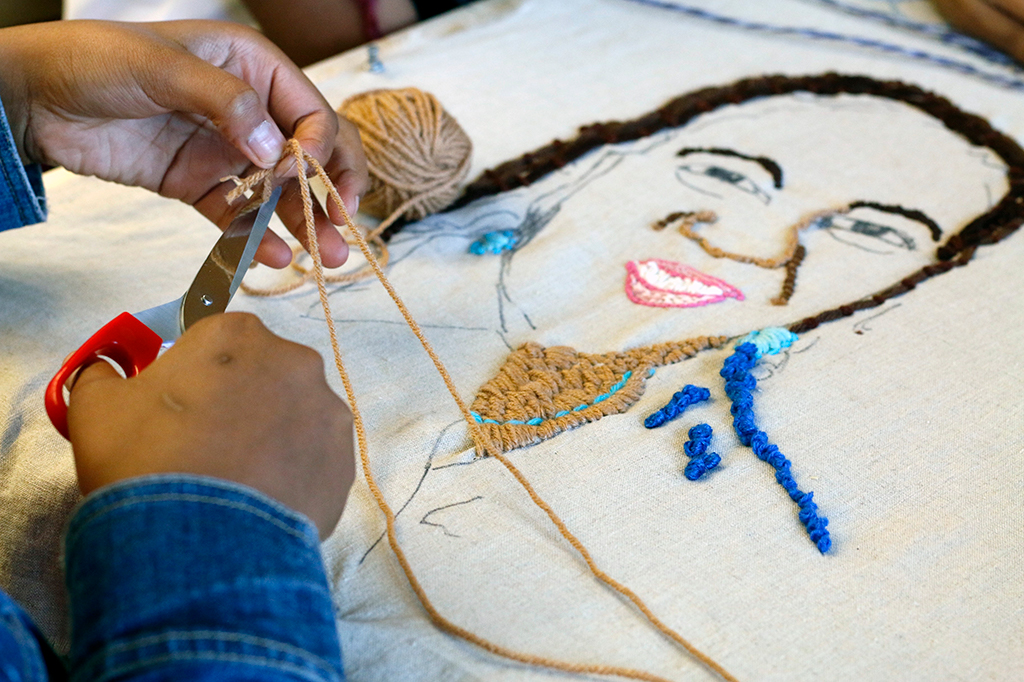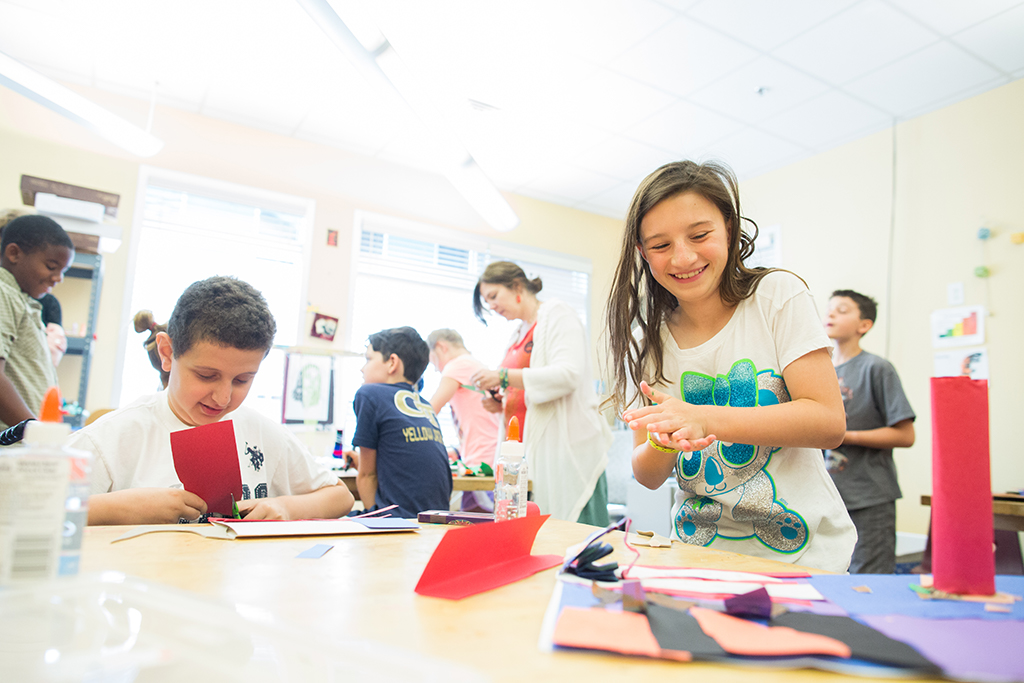Blog
Mark your calendar for YA Week 2015!
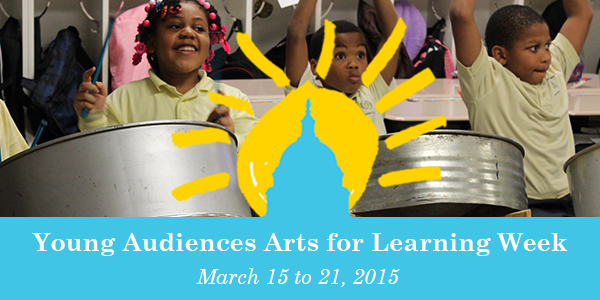
National Young Audiences Arts for Learning Week (YA Week) is a time to celebrate the national YA network of affiliates and show support for arts-in-education!
We hope you will join us in our celebration of the power of the arts in education during YA Week. Learn about the different ways you can get involved and show your support at yamd.org.
Check in with the Young Audiences Blog and follow us on Facebook and Twitter to stay updated as we countdown to #YAWeek 2015. You can also learn more about the U.S. House of Representatives Resolution marking March 15 to 21, 2015 YA Week here.
Donor Spotlight: Barbara and Mitch Krebs
Barbara and Mitch Krebs are both firm believers in the importance of the arts, even though their backgrounds are very different. Barbara holds a BFA in Theater and utilizes drama techniques to get into character when approaching her work as a corporate writer. Mitch is a business banker and claims to have two left brains, but he makes sure to balance his number-heavy career with a variety of arts experiences when not in the office.
The Krebs were surprised to learn that Young Audiences/Art for Learning had been providing professional development training to the teachers at their daughter Colette’s school, as well as artist-in-residence programs, for many years. They were intrigued by our work and started learning more. They saw first-hand with Colette that when the arts are integrated into the learning process as a result of the professional development training, it makes a huge difference in how kids learn and retain knowledge. The caliber of Young Audiences’ artists impressed them. “When I see these artists pour their hearts into their jobs,” says Barbara, “and how they get kids fired up about learning, I just want to make sure more and more kids get this experience.”
The scope of Young Audiences’ work in schools across Maryland is what moved the Krebs to join Young Audiences’ Sunburst Society, a multi-year giving society. “We wanted to offer our support because, throughout our lives, giving back to the community has been very important to us. And our focus for supporting groups has always been either in the arts or in education. And here was an organization that combined both of our favorites!”
The Krebs believe that, in an age of school budgets facing reduced arts funding, it will require public-private partnerships–like those that Young Audiences fosters with public schools across the state–to ensure that our children get the chance to continue learning in an environment that enhances the educational process. “It’s no surprise that when we think about our own school experiences, we always recall the teachers who did more than recite boring facts,” says Barbara. “We remember the teachers who incorporated memorable, arts-oriented teaching techniques and who made us think and create for ourselves.”
Young Audiences is grateful to Barbara and Mitch, and other members of the Sunburst Society, who make it possible for thousands of students to imagine, create, and realize their full potential through the arts.
Our Sunburst Society is made of generous donors whose high-level, multi-year pledges help to build a legacy of learning in, through, and about the arts. These contributions give Young Audiences the financial confidence to plan strategically for tomorrow’s educational needs, while meeting the demand for today’s programs. Join them.
Donor Spotlight: Barbara Howard
“Our main purpose in life as human beings is to help others,” believes Barbara Howard, special education teacher at the William S. Baer School in Baltimore. “When we do that, the blessings come back to us, ten-fold.” Barbara’s journey to teaching was a long one, but she knew, once her mother introduced the idea, that it was exactly where she needed to be.
As evidenced in the 2014 video “Beautiful Surprises,” Barbara is extremely dedicated to her students and cares deeply about helping them realize their full potential, and this is why she became not only a teacher partner, but also a donor. Young Audiences’ acclaimed Maryland Wolf Trap Early Learning Through the Arts 16-Session Residency, with embedded professional development, helps teachers like Barbara to develop arts-integrative teaching skills with proven outcomes. Designed to serve students ages three to five, this program has been a wonderful way to also serve children with disabilities. Working with Wolf Trap has helped Barbara to more effectively reach her students – all of whom learn differently and have unique needs – and build their confidence, while fostering in them a love of learning. As she puts it, “they have a purpose now in becoming successful in whatever they do.”
One student, Raymond, has continued to blossom since Wolf Trap came into his classroom and the Beautiful Surprises video was made. “As soon as Raymond comes into the classroom, he will walk over to the bin of tambourines,” shares Barbara. “He will pull his assigned one out of the bin and begin to play it. He, along with the other six children I teach, is the main reason as to why I rise each morning at 4:30. Sometimes I wonder, who’s teaching whom?”
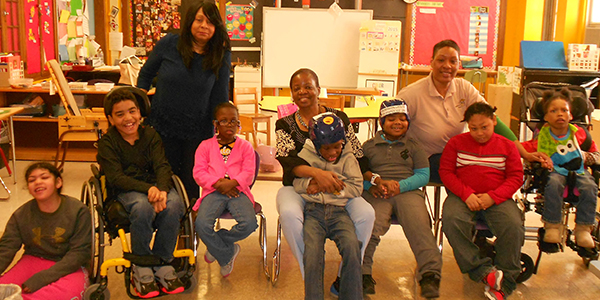 Young Audiences is grateful to have the support of dedicated individuals like Barbara, who share with us a vision to help many children flourish like never before.
Young Audiences is grateful to have the support of dedicated individuals like Barbara, who share with us a vision to help many children flourish like never before.
Join the Solstice Club today by pledging just $10 or more monthly, and your sustaining gift will help Young Audiences to continue to bring exceptional arts programs to students and offer professional development for both teachers and artists.
Donor Spotlight: Maryland State Arts Council
For more than 40 years, the Maryland State Arts Council (MSAC) has supported artists and arts organizations in their pursuit of artistic excellence, ensured the accessibility of the arts to all citizens, and promoted statewide awareness of arts resources and opportunities. Due to the MSAC’s support of both regional and statewide arts organizations, the arts community in Maryland is thriving. We are so proud to be a part of this community, and are grateful for the leadership of the MSAC.
As our single largest funder, the MSAC has helped Young Audiences provide high-quality arts experiences to hundreds of thousands of children across the state of Maryland, many of whom otherwise would not have had such experiences. It has also supported our work to offer exceptional artists the employment opportunities and salaries they deserve, and to underwrite costs for schools with limited resources through its Arts in Education Programs. In partnership with Arts Education in Maryland Schools (AEMS) Alliance, the MSAC also supports professional development for teaching artists through the Teaching Artist Institute (TAI), Maryland’s only state-wide artist training program that is made possible by the partnership of Arts Education in Maryland Schools Alliance, MSAC, and Young Audiences.
“The MSAC has chosen to partner with Young Audiences,” writes Theresa M. Colvin, Executive Director, “as they are uniquely qualified to carry out this important work because of their unwavering commitment to artistic excellence, their long-standing reputation across the state, and their tireless commitment to securing funding for underserved communities.”
The MSAC’s partnership with Young Audiences spans decades, and the impact is astounding. In the past 10 years, the MSAC has doubled its support, allowing Young Audiences to expand its number of services from 1,798 in 2004 to 12,509 in 2014–a 596% increase! We are proud to share the MSAC’s goal of investing in the arts across the state of Maryland, and are grateful for its continued support.
Student access to regular arts instruction and enrichment has greatly declined in the last 10 years. Help us change this by becoming an advocate for the arts today!
Help us keep Maryland’s arts community as vibrant as possible by becoming an advocate for the arts today! The MSAC not only supports Young Audiences in bringing the arts to thousands of students each year, but also ensures that the arts are accessible to all citizens in Maryland.
Donor Spotlight: Jamaal Collier
“Our life without the arts can be so empty,” rapped Jamaal Collier at Young Audience’s 2014 Impact Breakfast, “so I’m proud to be a part of YAMD!” A dynamic and engaging Hip Hop artist, Jamaal has been working with Young Audiences/Arts for Learning since 2007 and has served on its artist roster since 2013. His energy and passion for the arts is boundless, and show in the volume of work he does: not only does he offer assemblies and long-term residencies to elementary, middle, and high school students, but he also provides professional development for teachers, in addition to currently being trained for the renowned Maryland Wolf Trap Early Learning Through the Arts 16-session residencies for preschool and kindergarten students.
Jamaal began making donations to support Young Audiences ever since he joined Young Audiences’ roster. This past fall, he became the first roster artist to make a multi-year pledge of support. Asked why he chose to do this, especially since he dedicates so much time to the organization, Jamaal stated simply, “I believe in what we do. We do a lot, and there is a lot to be done.”
Jamaal’s passion for the arts is clear, as is the impact it has had on his life. Today he brings the power of the arts into the lives of students and teachers in Maryland. In every case, the results are remarkable. For example, during a Maryland Wolf Trap Early Learning Through the Arts program in Baltimore, Jamaal witnessed students evolve from using one-word answers to expressing themselves in full sentences!
Young Audiences is truly grateful to donors like Jamaal, whose passion for and commitment to the arts helps students realize their full potential. As he put it, speaking about the relationship between artists, teachers, and students, “We’re the ones who need each other, and we will help each other move forward.”
Schedule a program with a Young Audiences teaching artist today! Browse Young Audiences’ roster of more than 100 professional teaching artists, whose talent spans all art forms, including music, theater, dance, and visual arts.
Donor Spotlight: Wright Family Foundation
Since 2000, the Wright Family Foundation has supported diverse educational initiatives that provide intervention, support, and enrichment programs for at-risk children to realize their full potential. Young Audiences/Arts for Learning is extremely grateful for the partnership of the Wright Family Foundation and its support of our early learning initiative, Maryland Wolf Trap Early Learning Through the Arts 16-session residency program.
Young children have a natural curiosity and a unique love of learning. Young Audiences’ Wolf Trap residencies cultivate and encourage this love of learning in our youngest students by providing joyful, arts-integrated early learning programs in low-income schools throughout Baltimore. In addition to providing exceptional arts programming, Wolf Trap residencies are proven to increase student academic outcomes and improve teacher instructional practice. With the generous support of the Wright Family Foundation, Young Audiences has quadrupled the number of Wolf Trap residencies and increased the number of students served from 276 to over 1,100 – all in just three years.

According to the Wright Family Foundation, its support of Young Audiences grew out of its desire to provide children with opportunities to have arts-rich experiences. “One of our focus areas is Early Childhood Education,” writes Mari Beth Moulton, Executive Director. “When Young Audiences partnered with Wolf Trap to bring quality arts programs to early learning classrooms, we were eager to support this partnership. This is an opportunity for the Foundation and Young Audiences to have far-reaching impact for many of Baltimore’s children.”
The Wright Family Foundation is passionate about providing educational opportunities for our most at-risk youth in Baltimore. Young Audiences shares this passion, and is proud to partner with the Wright Family Foundation to provide our youngest students, in some of Baltimore’s most impoverished schools, with the opportunity to learn in and through the arts. With the support of generous donors like the Wright Family Foundation, we can offer a better and brighter future to our youngest students.
NRG Creatively Green festival coming to local schools

Young Audiences has announced two winning schools in the NRG Energy Creatively Green Award competition, sponsored by NRG Energy, Inc.: Chesapeake Public Charter School and Port Towns Elementary School!
Each winning school will host its own NRG Creatively Green Family Arts Festival for its school and community members with services worth up to $7,000. The two-and-a-half hour family arts festivals will consist of a performance by Young Audiences Blues musician Curtis Blues focusing on the importance of protecting the environment; hands‐on art making workshops led by a variety of Young Audiences teaching artists that promote environmental sustainability, from creating plastic monster puppets with old milk jugs to learning about kinetic energy through movement; and a community art‐making project to be played, displayed, or shared during the event. Each school has also garnered the support of a number of community organizations that will also be participating in the festivals.

The festivals will be held in May 2015 but Young Audiences artists are already hard at work creating family fun performances and workshops for the events. Artists recently gathered at the Young Audiences offices to participate in the Irvine Nature Center’s “Artistry of Nature” professional development workshop. Artists learned how to engage children in their environment, and even braved January’s snow and ice to explore the natural world right outside the office.
Congratulations to the winning schools!
Meet Our Artists: NRITYA

Young Audiences’ roster of artists continues to grow to encompass new artists, ensembles, and art forms, from slam poets to improvisers to Capoeira masters.
We’ll be regularly posting interviews with our artists, giving them a chance to share more about themselves and their experiences bringing their Young Audiences programs to schools. We recently sat down with Lakshmi Swaminathan of NRITYA.
How did you first hear about Young Audiences? What made you decide to become a roster artist?
During the 1990s, I lived in New York City where I was working as a dance teacher for Young Indian Culture Group. During that time, I connected with another New York City dance organization called Battery Dance Company when I was introduced to the executive director Jonathan Hollander. He invited me to his studio to attend a workshop where I met another classical Indian dancer, Janaki Patrik, who was a roster artist with the New York chapter of Young Audiences.
Janaki asked if I would be interested in becoming a Young Audiences artist and of course I said absolutely! So I joined her group, Caravan, an Indian dance ensemble. Later on in life, I moved to Maryland and took a few years to be a stay-at-home mom with my daughter. When I decided to get back into dance, I checked to see if the Maryland chapter of Young Audiences had showcased any Indian dancers or artists before. I shot an email to the former executive director asking if Young Audiences would be interested in having me as a new roster artist. Immediately following a positive response from the executive director, I completed a 45-minute assembly audition and that was it! I have been a member of Young Audiences/Arts for Learning Maryland since 2002.

What has been the most memorable part of the programs you have brought to students with Young Audiences? Do you have a favorite memory from a program?
So many! What NRITYA does is so different that I have seen evidence of it affecting children in so many positive ways. We have gone to many different parts of Maryland, including some very rural towns where experiences have stood out to me.
In these specific instances, I realized that some of the children seemed to be confused by the idea of what an “Indian” person is. I have received questions like: “Do you wear feathers in your hat?” or “Are you a queen?” It has been those types of questions that made me realize that these children have no clue what my heritage is. Upon first impression, they often identify me as a Native American rather than Indian. Through our programs, I have to first introduce them to the country of India and explain the difference. By allowing them to see an authentic Indian dance performance, we are giving them a glimpse into a different world and culture. They begin to experience something that is outside of their own comfort zone. It truly broadens their perspective.

How does your art form help connect students to what they are learning in school?
From the curriculum perspective, it helps students develop in social sciences. They spend time investigating the living history behind the cultures that they are learning about. Dance opens them up to the idea of freedom of expression. My dances tell stories. I usually do fables which have a very Western background. The fact that I am using the Indian dance form to tell a Western story forces children to realize that the medium of dance is not limiting. If you are able to successfully tell a Western English story through Indian dance moves, you can do almost anything! You can be creative and explore that creativity while having fun.
Through one of my dance residencies, “Indian Immersion,” the children actually get to wear authentically-made Indian clothes and immerse themselves further into the Indian culture. The kids love it! After one residency a teacher came up to me to say: “There is a boy in my class who would usually never participate or want to be involved in classroom activities. I was amazed to walk in and see him there dancing with you!” To watch kids just get up, start moving, and enjoy it is touching.
How do the lessons and skills you teach students about or through your art form apply to their everyday life outside of the classroom?
I think it broadens their perspective to a greater world outside of their own. I tell the children that India is a place very much like America. I have had kids ask if my studio would allow dancers to come in who are not of Indian descent. I tell them that you don’t have to be Indian to perform Indian dance!
After my program, children become culturally aware. They begin to notice differences between themselves and other people. They notice differences between the food we eat, our outfits, communication, and how we express stories and emotions through dance. Yet at the same time, they realize that dance is dance. It’s a medium of expressing oneself. It is a medium of using your body to tell a story no matter what culture you come from.
When we bring Indian dance to students, we give them an opportunity to step outside of their schools, and see beyond their immediate neighborhoods. This is a way of letting them know that it is all right to be different. It’s all right to be creative. It’s all right to embrace art. There is a world outside of academics that allows children to grow.
Learn more about NRITYA’s offerings through Young Audiences.
Teach fractions with beatboxing in February’s smART Tip

In February’s smART Tip, Young Audiences beatboxer Max Bent shares the basics of vocal percussion and how it can connect to other subjects, such as fraction units in math. Press play below!
[youtube http://youtu.be/5WEcbnQWcAM]
smART Tips is a monthly video series sharing tips for educators who are interested in new, creative ways to use the arts in their classroom with students. See all smART Tips to date here. Interested in a specific topic? Let us know!
A Piece of the Bay

By Lori Mellendick, fifth-grade art teacher at Ducketts Lane Elementary
This December, my fifth-grade students gathered around a table functioning as young archaeologists, researchers, and artists. Their collaborative clay mural sat before them covered in grout waiting to be exposed. As my students began to buff the dried grout away, the ceramic animals they sculpted and arranged in the mural earlier in the fall began to pop through. My class had been working toward this moment since Young Audiences visual artist Amanda Pellerin first arrived as our artist-in-residence in October.
The massive four-by-eight-foot panels of the mural took up the entire floor. I didn’t realize how busy my classroom could be as we built something so large. Slowly, a vast food web stretched across the mural revealing the entire habitat network of the Chesapeake Bay.
On this final culminating day, my students experienced what we like to call their “Aha!” moment. They took a step back and discovered harmony behind their mural as a collaboration. The looks on their faces expressed the “now we get it” type of feeling. They ended by celebrating each other by giving and receiving compliments of their work. The positive energy in the room was out of control!
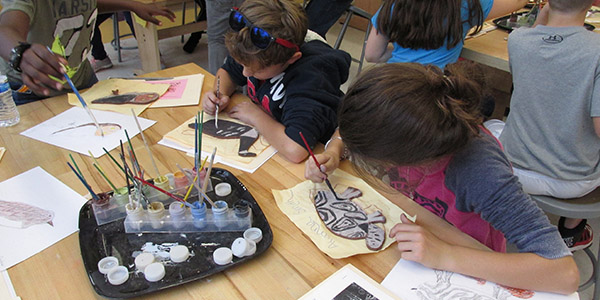
In October, my students had spent five days conducting research of Maryland animals surrounding the Chesapeake Bay as a theme. They built an understanding of how these animals survive depending on their diets. The students also investigated the Chesapeake’s surrounding habitat by studying the water cycles, plants, and local natural resources. In order to display these facts on a visual web, the students had to be imaginative. This is where Amanda’s expertise came in. Amanda guided students through the necessary steps to creatively assemble this piece of work.
There were times when kids pondered whether or not they should take an artistic risk by making verbal decisions in front of a group. When energy subsided, some surprising moments occurred when a few particularly shy students stepped up to the plate and made executive decisions for the group. It was a wonderful chance for students to express creativity in ways that they didn’t expect to, especially within the subject of science.
I wanted to find a meaningful residency that would integrate the arts into the subject of science. I knew that this was the perfect opportunity to find a project that could cover environmental research in a creative way. Knowing Amanda’s experience as a Young Audiences roster artist, I knew that the kids would get a lot out of the program.
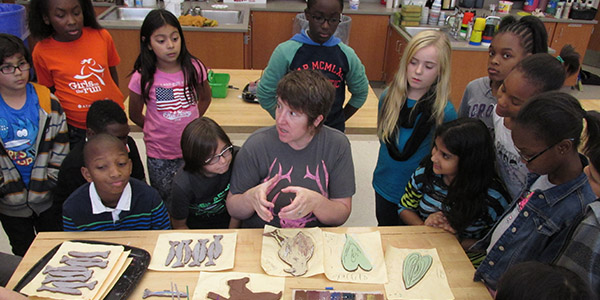
It was important to bring in an outside artist because it gave some of our teachers an understanding of how the artistic process works. Teaching children artistic behaviors is important because it demonstrates tasks such as researching, modifying, and executing that energy into a product. It doesn’t work like a magic trick where *poof*, a beautiful piece of artwork suddenly appears. It takes work. It’s similar to the scientific process. You formulate a hypothesis, test your theories, and then provide a conclusion statement in the end. In this case, our conclusion was a mural that demonstrated a deeper understanding of the Chesapeake Bay.
Using a tactile form such as clay, gave students a substantial gift in the end. Since these fifth graders will be going onto middle school very soon, I wanted to give them an opportunity to leave their mark upon the school. In April, there will be an unveiling of the mural in a reserved space across from a beautiful fountain. Strong light filters into this area which will give the mural the perfect spotlight that it deserves. We can’t wait to put it up!
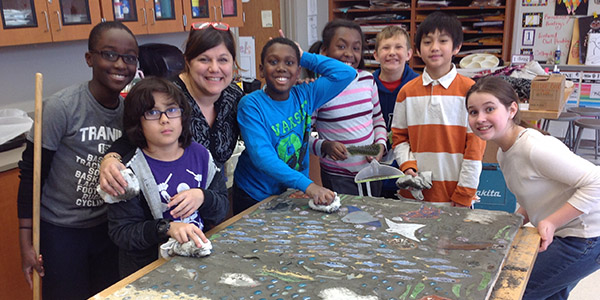
When you are studying something across the board of a curriculum, it resonates with children. It hits on so many different content levels. These experiences give so much more meaning to the students than you would expect. I immediately go back to my own experiences and remember the impact that resident artists had upon me in school. I wanted to give my students that same opportunity.
Learn more about Amanda and her programs for schools at yamd.org.
YA launches new five-year strategic plan

In July 2014, Young Audiences adopted its new five-year strategic plan, “Transforming the Lives and Education of Our Youth.” In the coming weeks, we will profile our four strategic directions and our exciting plans related to each. To kick off this series, Stacie Sanders Evans, Young Audiences executive director, wrote about how the plan was created and the exciting work that is to come.
More than 300 volunteers contributed to Young Audiences’ strategic planning process, spanning May 2013 to July 2014, to build an ambitious new strategic plan that sets the organization’s course for the next five years to significantly grow its reach–ultimately impacting the education of 50,000 more young people across this state every year.
During the development of the plan, Young Audiences worked with two consultants to conduct an external and internal review of the organization; more than 50 board members, staff members, artists, teachers, organizational funders, and school administrators gathered for a day-long strategic planning retreat; and smaller working groups composed of artists and educators spent two months exploring six strategic areas that came out of the retreat’s discussions and developed goals for the plan. It was an honor to co-lead this work with Bill Buckner, chair of the Strategic Planning Committee and Young Audiences’ immediate past board president. Our new plan was adopted by our board in July 2014 and since then our staff and board have been laying the foundation necessary to take on the challenges laid out in our plan.
Some of you may not be aware that Young Audiences is the nation’s largest arts education network and it began in Baltimore in 1950. During our 64-year history, the Maryland affiliate of Young Audiences has continually expanded its services to Maryland students, teachers, and artists to give more students the opportunity to experience and learn through the arts. We are proud of our rich history and roots as an organization focused on exposing young people to the arts. Yet, we are increasingly excited by our evolving role as an education organization that is transforming the lives and education of young people by building communities of educators, professional artists, and parents and enabling them to help our children realize their full potential through the arts.
The Next Five Years
Our vision remains the same as it did five years ago: “One day, every student in Maryland will have the opportunity to imagine, to create, and to realize their full potential through the arts.” Our mission also remains unchanged: “To transform the lives and education of youth through the arts by connecting educators, professional artists, and communities.”
What has changed is that now, more than any other time in our history, Young Audiences is poised to realize this vision and achieve this mission for all Maryland children.
During the next five years we plan to significantly increase Young Audiences’ transformative impact on students and on education, and to accomplish this by:
- Expanding our school district arts integration partnerships
- Investing in and growing our teaching artist community
- Building and sharing evidence of our impact
- Strengthening and expanding our programs
Through a series of blog posts, I will dive deeper into each aspect of this plan and share updates on our progress. I welcome your feedback and participation in our work.
We are excited about the power of the arts to improve educational and life outcomes for students, and we are proud of our plans and the community we are building to leverage the arts to have the greatest impact possible on our students. We hope you will join us in this work!
– Stacie Sanders Evans, Young Audiences Executive Director
You can read the full plan at yamd.org.
To learn more Young Audiences’ mission and our work, we invite you to join us at one of our upcoming On the Bright Side Tours. Learn more and sign up online.
Make your own drums with January’s smART Tip
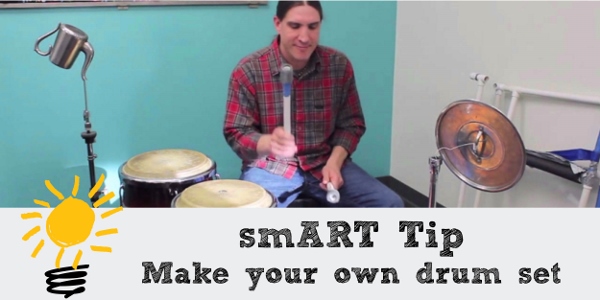
In our January smART Tip, Young Audiences musician and percussionist Steve Cyphers shows how you can easily and inexpensively create bucket drums for your students with materials found at your local hardware store. Get started by pressing play below.
[youtube http://youtu.be/rWIGPp_NTOs?list=PLUssR-3GtBZfiKXpU72zQAkgXh3wBcBzQ]
smART Tips is a monthly video series sharing tips for educators who are interested in new, creative ways to use the arts in their classroom with students. See all smART Tips to date here. Interested in a specific topic? Let us know!









